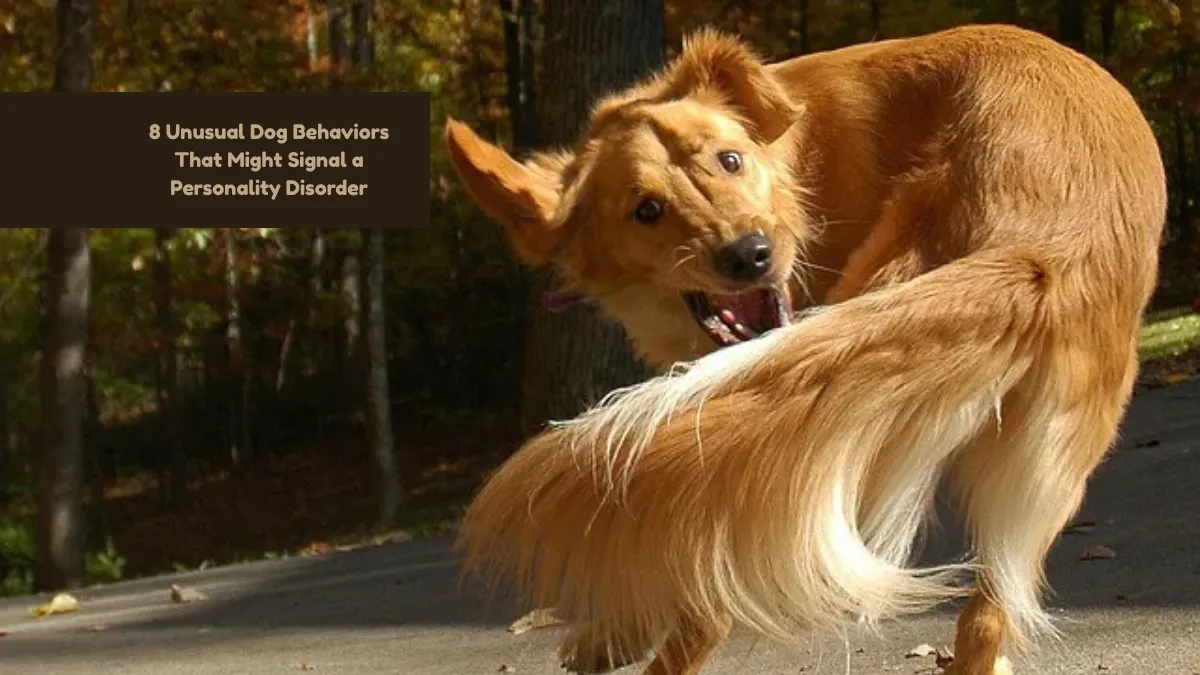Dogs, much like humans, can display various peculiar behaviors that are often mistaken for simple quirks. However, some of these actions could point to deeper personality disorders. Recognizing these traits can help address potential issues early, ensuring your dog enjoys a happy, healthy life. Let’s take a closer look at 12 strange behaviors that could indicate your dog has a personality disorder.
1. Obsessive Tail Chasing
If your dog chases its tail incessantly, as if stuck in an endless loop, it could be more than just playful behavior. This obsessive tail chasing can be a sign of anxiety or a compulsive disorder. What may start as innocent fun can escalate into a repetitive behavior if not addressed. Some breeds, such as Bull Terriers, are genetically predisposed to this behavior. Early consultation with a veterinarian can help prevent further issues.
Fun Fact: Certain breeds are more likely to exhibit tail-chasing behaviors due to genetic tendencies.
2. Excessive Barking at Shadows
Have you ever noticed your dog barking at shadows? This strange behavior might indicate anxiety or confusion, and dogs often do it out of fear. It’s important to identify the cause of their distress and address it promptly. Lack of mental stimulation can also contribute to this behavior. Simple environmental adjustments or interactive playtime can help alleviate it.
Did You Know? Mental engagement can significantly reduce the occurrence of shadow-related barking.
3. Persistent Pacing
If your dog is constantly pacing back and forth, it may be showing signs of anxiety or stress. This restless behavior can occur when your dog experiences changes in their environment or routine. Persistent pacing is not just physical activity; it’s a mental signal that something is wrong. Calming music, familiar scents, and extra playtime might help reduce their unease.
Interesting Fact: Dogs, just like humans, experience stress and frustration when faced with unfamiliar situations.
4. Compulsive Licking
Compulsive licking, especially when a dog constantly licks its paws or other body parts, could indicate anxiety or boredom. This behavior can lead to skin irritation and other health issues if left unchecked. Identifying stress triggers and increasing physical exercise or mental stimulation can help. In some cases, allergies may also contribute to this issue, so a vet check is essential.
Fun Tidbit: Some dogs may lick excessively due to allergies or discomfort, rather than just emotional reasons.
5. Aggression Without Cause
Unexpected aggression can be concerning, especially when there’s no clear trigger. It may be linked to fear, territorial instincts, or even undiagnosed pain. Identifying the underlying cause is crucial to manage this behavior effectively. In some cases, professional training or behavioral therapy can help prevent aggressive incidents.
Did You Know? Sometimes, aggression may stem from an undiagnosed medical condition, making a vet consultation important.
6. Fear of Everyday Objects
If your dog reacts fearfully to everyday items like vacuum cleaners, shoes, or bags, it could signal irrational fears tied to anxiety. These phobias can hinder their ability to function normally. Gradual exposure and positive reinforcement can help them overcome these fears and build confidence.
Fascinating Fact: Dogs’ heightened senses can make ordinary objects seem threatening, especially if they associate them with negative experiences.
7. Refusal to Eat
A sudden loss of appetite in your dog may seem like a minor issue, but it could indicate underlying stress or digestive issues. Picky eating habits or a complete refusal to eat should not be ignored, as they could signify emotional distress or discomfort. Establishing a consistent feeding routine and observing for other signs of illness can provide important clues.
Did You Know? Negative associations with food or changes in routine may contribute to a dog’s reluctance to eat.
8. Destructive Chewing
When your dog starts chewing everything in sight, it’s often a sign of frustration or separation anxiety. Destructive chewing isn’t just an annoying habit; it’s a signal that your dog may need more mental stimulation or exercise. Providing chew toys and ensuring enough playtime can help curb this behavior.
Fun Fact: Puppies chew to relieve teething pain, but in adult dogs, it may point to a deeper emotional issue, such as anxiety.
9. Avoidance of Eye Contact
If your dog avoids making eye contact with you, it may indicate fear or submission, especially if it has an uncertain past. Avoidance of eye contact can hinder communication and bonding between you and your pet. Patience, gentle interaction, and trust-building can help improve their confidence.
Intriguing Tidbit: In canine communication, direct eye contact can be interpreted as a challenge, so some dogs avoid it naturally.
FAQs
Q: What should I do if my dog starts obsessive tail chasing?
A: If tail chasing becomes repetitive, consult a vet. It could be a sign of anxiety or a compulsive disorder that needs professional attention.
Q: How can I stop my dog from barking at shadows?
A: Engage your dog in stimulating activities and assess the environment for stressors. A lack of mental stimulation might be the root cause.
Q: Why is my dog suddenly refusing to eat?
A: Loss of appetite could indicate stress or digestive issues. Maintain a regular feeding schedule and consult a vet if the problem persists.
Q: What can I do about my dog’s destructive chewing?
A: Provide chew toys and ensure adequate physical and mental stimulation. Destructive chewing is often a sign of frustration or anxiety.
Final Thought
Recognizing these unusual behaviors in your dog early can make a world of difference. Whether it’s anxiety, boredom, or something more serious, addressing these signs promptly can help your dog live a healthier, happier life. Always consult a veterinarian when in doubt, and be patient as you work with your furry friend to improve their well-being.
